Report on Personal and Professional Development and Learning Styles
VerifiedAdded on 2020/06/04
|15
|4251
|43
Report
AI Summary
This report delves into the multifaceted realm of personal and professional development, offering a comprehensive overview of self-managed learning approaches and diverse learning styles. It explores strategies for encouraging lifelong learning, emphasizing the advantages of self-managed learning for both individuals and organizations. The report identifies common workplace problems and proposes effective solutions, alongside an analysis of communication at different organizational levels. Furthermore, it assesses effective time management strategies, providing insights into skill and competency development, the identification of personal development needs, and the creation of development plans. The report concludes with an examination of short and long-term objectives, the implementation of plans, and the evaluation of learning outcomes, providing valuable insights for enhancing personal and professional growth.
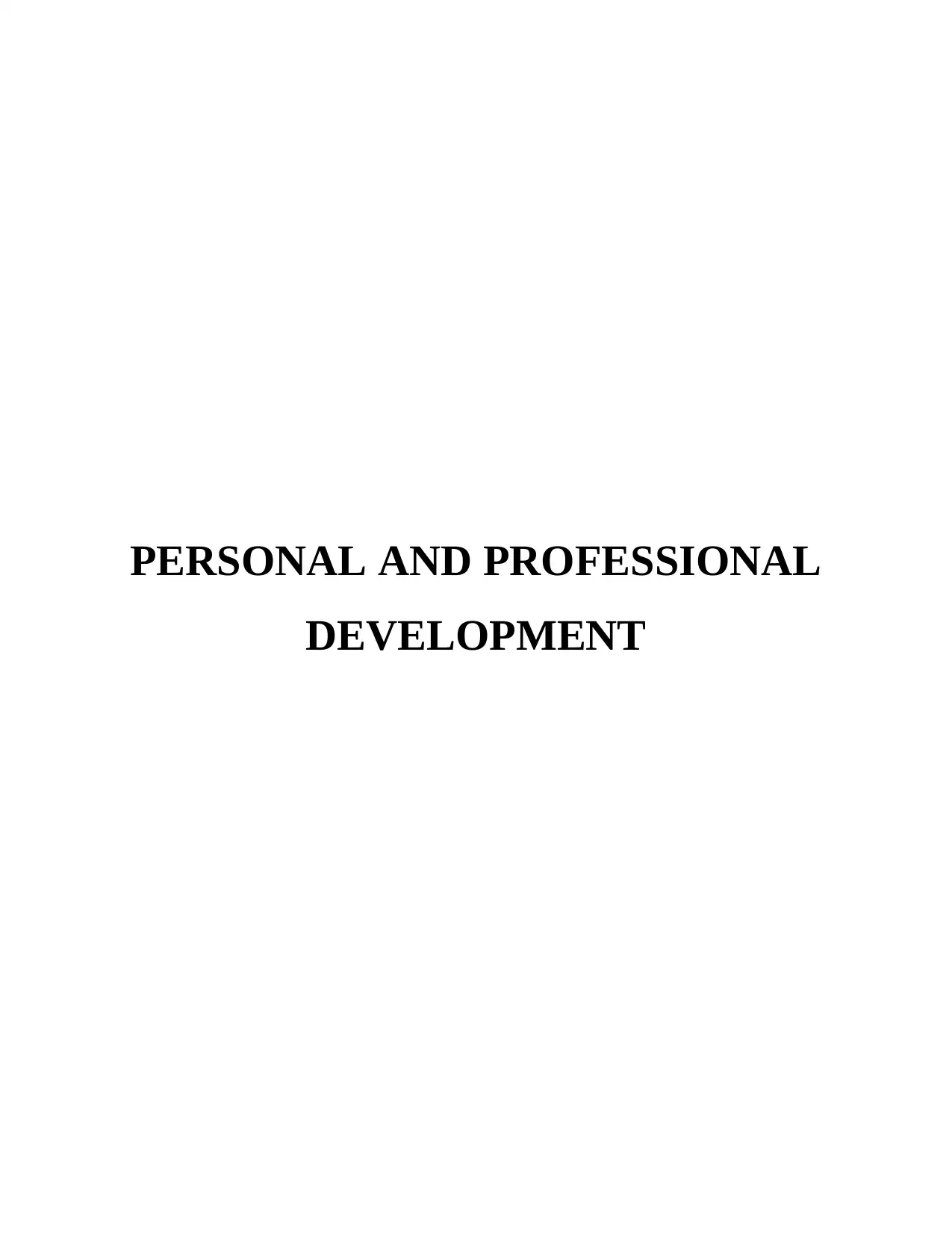
PERSONAL AND PROFESSIONAL
DEVELOPMENT
DEVELOPMENT
Paraphrase This Document
Need a fresh take? Get an instant paraphrase of this document with our AI Paraphraser
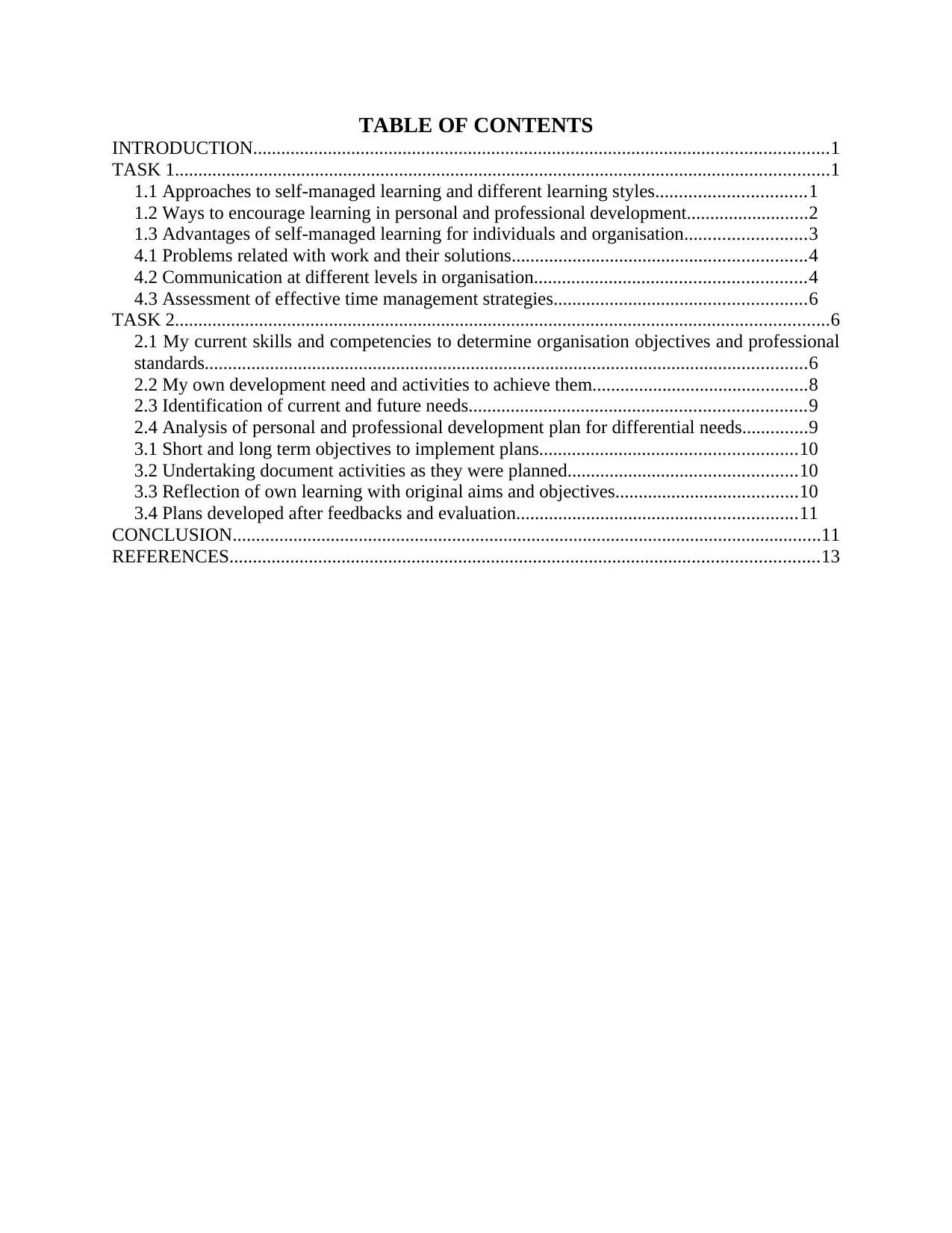
TABLE OF CONTENTS
INTRODUCTION...........................................................................................................................1
TASK 1............................................................................................................................................1
1.1 Approaches to self-managed learning and different learning styles................................1
1.2 Ways to encourage learning in personal and professional development..........................2
1.3 Advantages of self-managed learning for individuals and organisation..........................3
4.1 Problems related with work and their solutions...............................................................4
4.2 Communication at different levels in organisation..........................................................4
4.3 Assessment of effective time management strategies......................................................6
TASK 2............................................................................................................................................6
2.1 My current skills and competencies to determine organisation objectives and professional
standards.................................................................................................................................6
2.2 My own development need and activities to achieve them..............................................8
2.3 Identification of current and future needs........................................................................9
2.4 Analysis of personal and professional development plan for differential needs..............9
3.1 Short and long term objectives to implement plans.......................................................10
3.2 Undertaking document activities as they were planned.................................................10
3.3 Reflection of own learning with original aims and objectives.......................................10
3.4 Plans developed after feedbacks and evaluation............................................................11
CONCLUSION..............................................................................................................................11
REFERENCES..............................................................................................................................13
INTRODUCTION...........................................................................................................................1
TASK 1............................................................................................................................................1
1.1 Approaches to self-managed learning and different learning styles................................1
1.2 Ways to encourage learning in personal and professional development..........................2
1.3 Advantages of self-managed learning for individuals and organisation..........................3
4.1 Problems related with work and their solutions...............................................................4
4.2 Communication at different levels in organisation..........................................................4
4.3 Assessment of effective time management strategies......................................................6
TASK 2............................................................................................................................................6
2.1 My current skills and competencies to determine organisation objectives and professional
standards.................................................................................................................................6
2.2 My own development need and activities to achieve them..............................................8
2.3 Identification of current and future needs........................................................................9
2.4 Analysis of personal and professional development plan for differential needs..............9
3.1 Short and long term objectives to implement plans.......................................................10
3.2 Undertaking document activities as they were planned.................................................10
3.3 Reflection of own learning with original aims and objectives.......................................10
3.4 Plans developed after feedbacks and evaluation............................................................11
CONCLUSION..............................................................................................................................11
REFERENCES..............................................................................................................................13
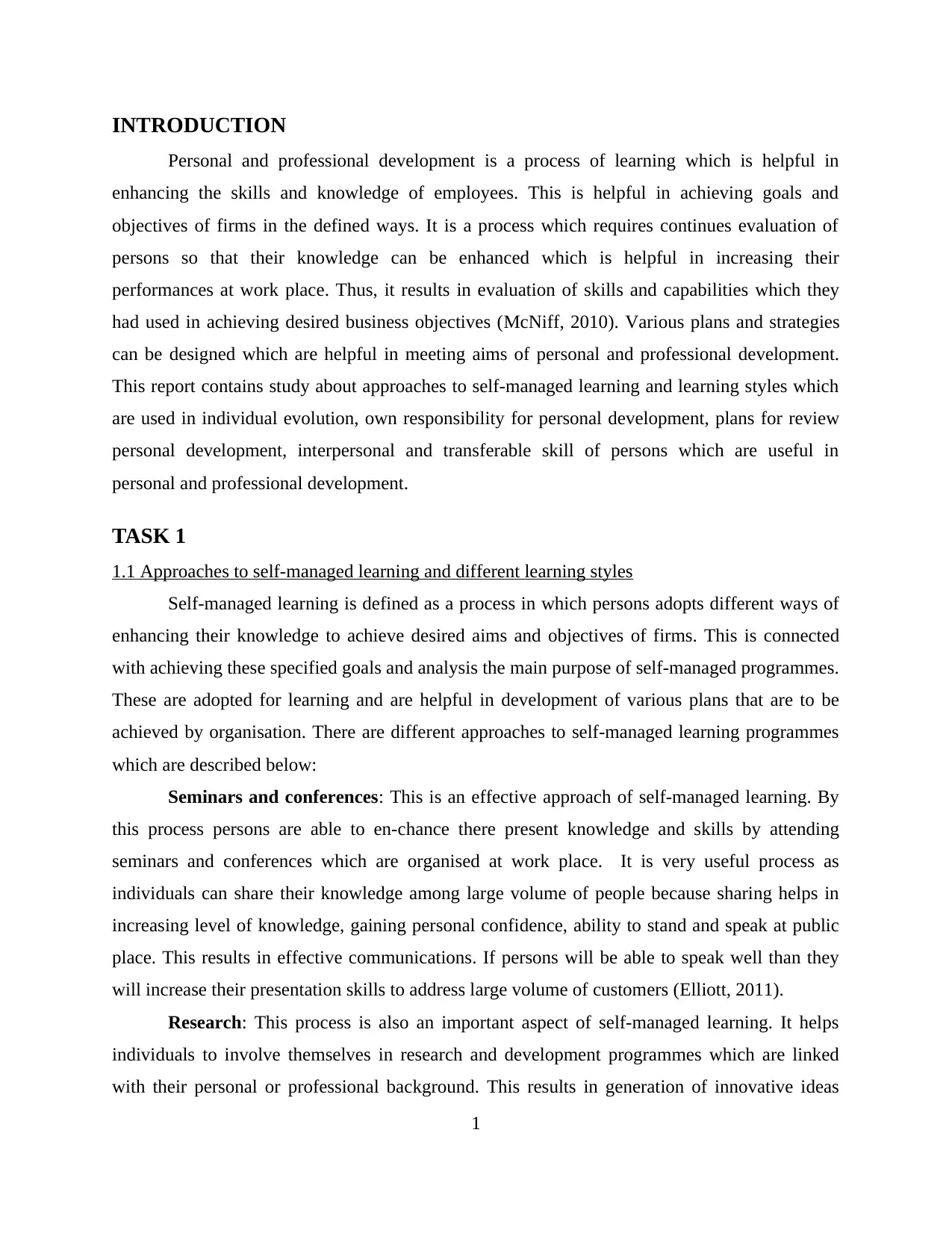
INTRODUCTION
Personal and professional development is a process of learning which is helpful in
enhancing the skills and knowledge of employees. This is helpful in achieving goals and
objectives of firms in the defined ways. It is a process which requires continues evaluation of
persons so that their knowledge can be enhanced which is helpful in increasing their
performances at work place. Thus, it results in evaluation of skills and capabilities which they
had used in achieving desired business objectives (McNiff, 2010). Various plans and strategies
can be designed which are helpful in meeting aims of personal and professional development.
This report contains study about approaches to self-managed learning and learning styles which
are used in individual evolution, own responsibility for personal development, plans for review
personal development, interpersonal and transferable skill of persons which are useful in
personal and professional development.
TASK 1
1.1 Approaches to self-managed learning and different learning styles
Self-managed learning is defined as a process in which persons adopts different ways of
enhancing their knowledge to achieve desired aims and objectives of firms. This is connected
with achieving these specified goals and analysis the main purpose of self-managed programmes.
These are adopted for learning and are helpful in development of various plans that are to be
achieved by organisation. There are different approaches to self-managed learning programmes
which are described below:
Seminars and conferences: This is an effective approach of self-managed learning. By
this process persons are able to en-chance there present knowledge and skills by attending
seminars and conferences which are organised at work place. It is very useful process as
individuals can share their knowledge among large volume of people because sharing helps in
increasing level of knowledge, gaining personal confidence, ability to stand and speak at public
place. This results in effective communications. If persons will be able to speak well than they
will increase their presentation skills to address large volume of customers (Elliott, 2011).
Research: This process is also an important aspect of self-managed learning. It helps
individuals to involve themselves in research and development programmes which are linked
with their personal or professional background. This results in generation of innovative ideas
1
Personal and professional development is a process of learning which is helpful in
enhancing the skills and knowledge of employees. This is helpful in achieving goals and
objectives of firms in the defined ways. It is a process which requires continues evaluation of
persons so that their knowledge can be enhanced which is helpful in increasing their
performances at work place. Thus, it results in evaluation of skills and capabilities which they
had used in achieving desired business objectives (McNiff, 2010). Various plans and strategies
can be designed which are helpful in meeting aims of personal and professional development.
This report contains study about approaches to self-managed learning and learning styles which
are used in individual evolution, own responsibility for personal development, plans for review
personal development, interpersonal and transferable skill of persons which are useful in
personal and professional development.
TASK 1
1.1 Approaches to self-managed learning and different learning styles
Self-managed learning is defined as a process in which persons adopts different ways of
enhancing their knowledge to achieve desired aims and objectives of firms. This is connected
with achieving these specified goals and analysis the main purpose of self-managed programmes.
These are adopted for learning and are helpful in development of various plans that are to be
achieved by organisation. There are different approaches to self-managed learning programmes
which are described below:
Seminars and conferences: This is an effective approach of self-managed learning. By
this process persons are able to en-chance there present knowledge and skills by attending
seminars and conferences which are organised at work place. It is very useful process as
individuals can share their knowledge among large volume of people because sharing helps in
increasing level of knowledge, gaining personal confidence, ability to stand and speak at public
place. This results in effective communications. If persons will be able to speak well than they
will increase their presentation skills to address large volume of customers (Elliott, 2011).
Research: This process is also an important aspect of self-managed learning. It helps
individuals to involve themselves in research and development programmes which are linked
with their personal or professional background. This results in generation of innovative ideas
1
⊘ This is a preview!⊘
Do you want full access?
Subscribe today to unlock all pages.

Trusted by 1+ million students worldwide
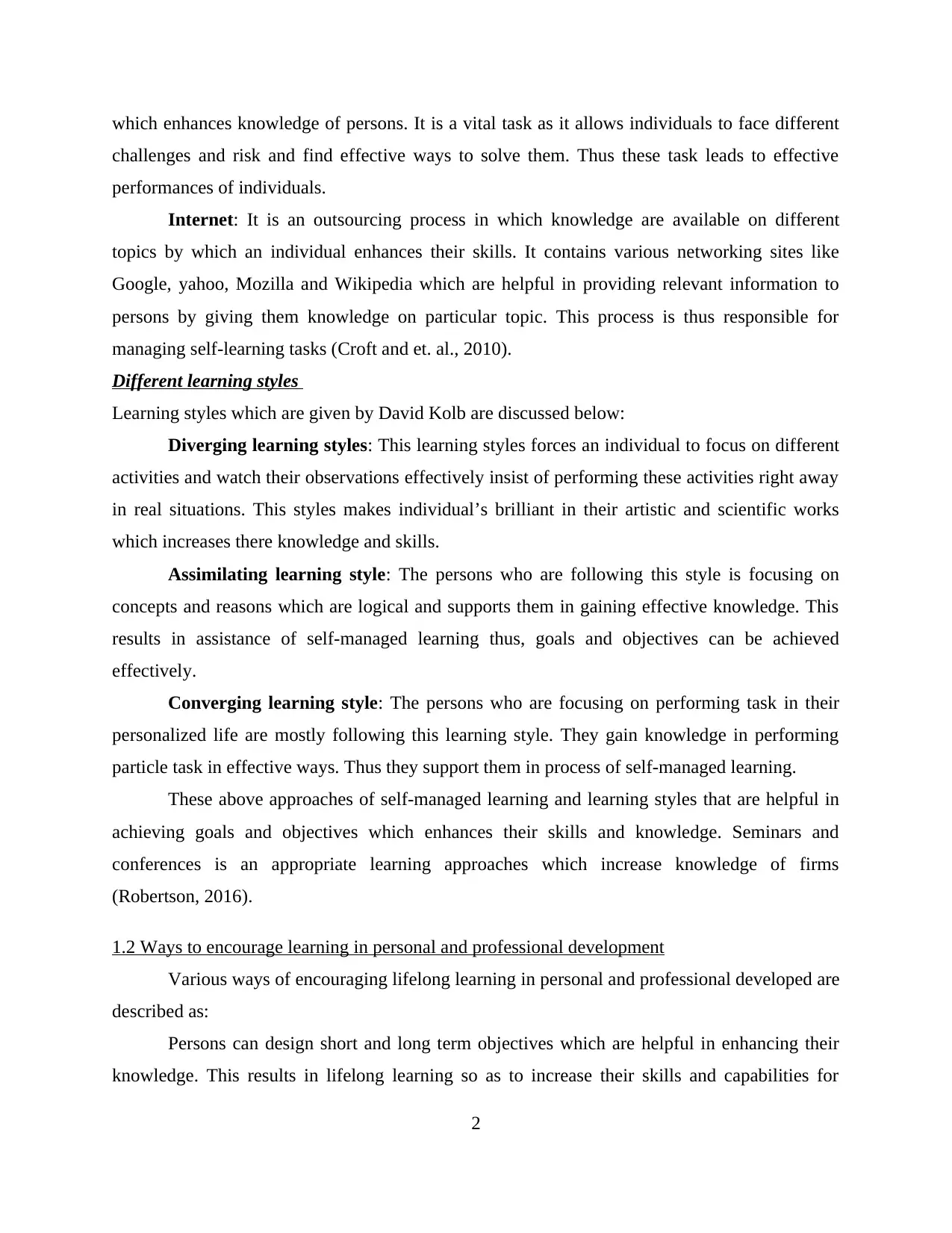
which enhances knowledge of persons. It is a vital task as it allows individuals to face different
challenges and risk and find effective ways to solve them. Thus these task leads to effective
performances of individuals.
Internet: It is an outsourcing process in which knowledge are available on different
topics by which an individual enhances their skills. It contains various networking sites like
Google, yahoo, Mozilla and Wikipedia which are helpful in providing relevant information to
persons by giving them knowledge on particular topic. This process is thus responsible for
managing self-learning tasks (Croft and et. al., 2010).
Different learning styles
Learning styles which are given by David Kolb are discussed below:
Diverging learning styles: This learning styles forces an individual to focus on different
activities and watch their observations effectively insist of performing these activities right away
in real situations. This styles makes individual’s brilliant in their artistic and scientific works
which increases there knowledge and skills.
Assimilating learning style: The persons who are following this style is focusing on
concepts and reasons which are logical and supports them in gaining effective knowledge. This
results in assistance of self-managed learning thus, goals and objectives can be achieved
effectively.
Converging learning style: The persons who are focusing on performing task in their
personalized life are mostly following this learning style. They gain knowledge in performing
particle task in effective ways. Thus they support them in process of self-managed learning.
These above approaches of self-managed learning and learning styles that are helpful in
achieving goals and objectives which enhances their skills and knowledge. Seminars and
conferences is an appropriate learning approaches which increase knowledge of firms
(Robertson, 2016).
1.2 Ways to encourage learning in personal and professional development
Various ways of encouraging lifelong learning in personal and professional developed are
described as:
Persons can design short and long term objectives which are helpful in enhancing their
knowledge. This results in lifelong learning so as to increase their skills and capabilities for
2
challenges and risk and find effective ways to solve them. Thus these task leads to effective
performances of individuals.
Internet: It is an outsourcing process in which knowledge are available on different
topics by which an individual enhances their skills. It contains various networking sites like
Google, yahoo, Mozilla and Wikipedia which are helpful in providing relevant information to
persons by giving them knowledge on particular topic. This process is thus responsible for
managing self-learning tasks (Croft and et. al., 2010).
Different learning styles
Learning styles which are given by David Kolb are discussed below:
Diverging learning styles: This learning styles forces an individual to focus on different
activities and watch their observations effectively insist of performing these activities right away
in real situations. This styles makes individual’s brilliant in their artistic and scientific works
which increases there knowledge and skills.
Assimilating learning style: The persons who are following this style is focusing on
concepts and reasons which are logical and supports them in gaining effective knowledge. This
results in assistance of self-managed learning thus, goals and objectives can be achieved
effectively.
Converging learning style: The persons who are focusing on performing task in their
personalized life are mostly following this learning style. They gain knowledge in performing
particle task in effective ways. Thus they support them in process of self-managed learning.
These above approaches of self-managed learning and learning styles that are helpful in
achieving goals and objectives which enhances their skills and knowledge. Seminars and
conferences is an appropriate learning approaches which increase knowledge of firms
(Robertson, 2016).
1.2 Ways to encourage learning in personal and professional development
Various ways of encouraging lifelong learning in personal and professional developed are
described as:
Persons can design short and long term objectives which are helpful in enhancing their
knowledge. This results in lifelong learning so as to increase their skills and capabilities for
2
Paraphrase This Document
Need a fresh take? Get an instant paraphrase of this document with our AI Paraphraser
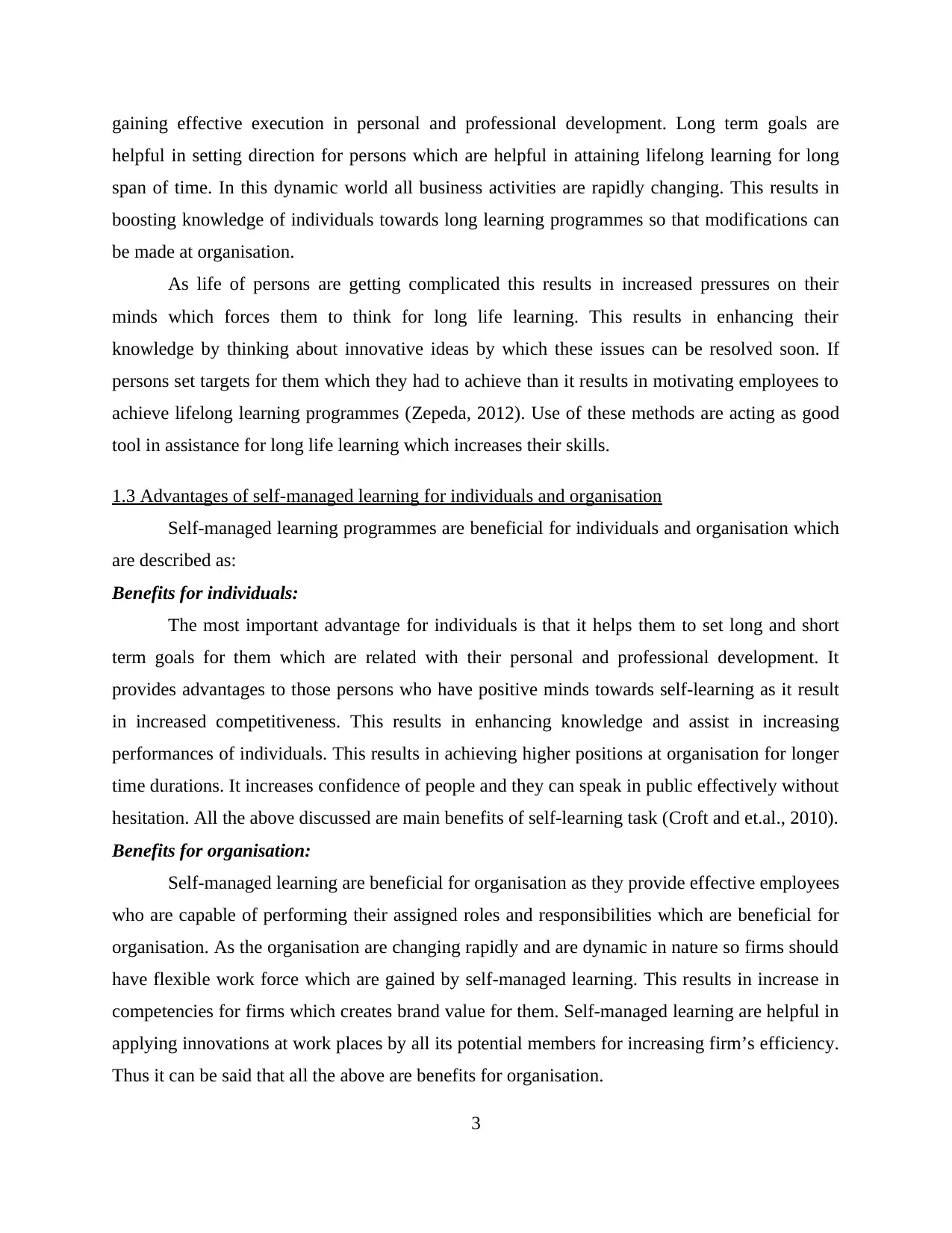
gaining effective execution in personal and professional development. Long term goals are
helpful in setting direction for persons which are helpful in attaining lifelong learning for long
span of time. In this dynamic world all business activities are rapidly changing. This results in
boosting knowledge of individuals towards long learning programmes so that modifications can
be made at organisation.
As life of persons are getting complicated this results in increased pressures on their
minds which forces them to think for long life learning. This results in enhancing their
knowledge by thinking about innovative ideas by which these issues can be resolved soon. If
persons set targets for them which they had to achieve than it results in motivating employees to
achieve lifelong learning programmes (Zepeda, 2012). Use of these methods are acting as good
tool in assistance for long life learning which increases their skills.
1.3 Advantages of self-managed learning for individuals and organisation
Self-managed learning programmes are beneficial for individuals and organisation which
are described as:
Benefits for individuals:
The most important advantage for individuals is that it helps them to set long and short
term goals for them which are related with their personal and professional development. It
provides advantages to those persons who have positive minds towards self-learning as it result
in increased competitiveness. This results in enhancing knowledge and assist in increasing
performances of individuals. This results in achieving higher positions at organisation for longer
time durations. It increases confidence of people and they can speak in public effectively without
hesitation. All the above discussed are main benefits of self-learning task (Croft and et.al., 2010).
Benefits for organisation:
Self-managed learning are beneficial for organisation as they provide effective employees
who are capable of performing their assigned roles and responsibilities which are beneficial for
organisation. As the organisation are changing rapidly and are dynamic in nature so firms should
have flexible work force which are gained by self-managed learning. This results in increase in
competencies for firms which creates brand value for them. Self-managed learning are helpful in
applying innovations at work places by all its potential members for increasing firm’s efficiency.
Thus it can be said that all the above are benefits for organisation.
3
helpful in setting direction for persons which are helpful in attaining lifelong learning for long
span of time. In this dynamic world all business activities are rapidly changing. This results in
boosting knowledge of individuals towards long learning programmes so that modifications can
be made at organisation.
As life of persons are getting complicated this results in increased pressures on their
minds which forces them to think for long life learning. This results in enhancing their
knowledge by thinking about innovative ideas by which these issues can be resolved soon. If
persons set targets for them which they had to achieve than it results in motivating employees to
achieve lifelong learning programmes (Zepeda, 2012). Use of these methods are acting as good
tool in assistance for long life learning which increases their skills.
1.3 Advantages of self-managed learning for individuals and organisation
Self-managed learning programmes are beneficial for individuals and organisation which
are described as:
Benefits for individuals:
The most important advantage for individuals is that it helps them to set long and short
term goals for them which are related with their personal and professional development. It
provides advantages to those persons who have positive minds towards self-learning as it result
in increased competitiveness. This results in enhancing knowledge and assist in increasing
performances of individuals. This results in achieving higher positions at organisation for longer
time durations. It increases confidence of people and they can speak in public effectively without
hesitation. All the above discussed are main benefits of self-learning task (Croft and et.al., 2010).
Benefits for organisation:
Self-managed learning are beneficial for organisation as they provide effective employees
who are capable of performing their assigned roles and responsibilities which are beneficial for
organisation. As the organisation are changing rapidly and are dynamic in nature so firms should
have flexible work force which are gained by self-managed learning. This results in increase in
competencies for firms which creates brand value for them. Self-managed learning are helpful in
applying innovations at work places by all its potential members for increasing firm’s efficiency.
Thus it can be said that all the above are benefits for organisation.
3
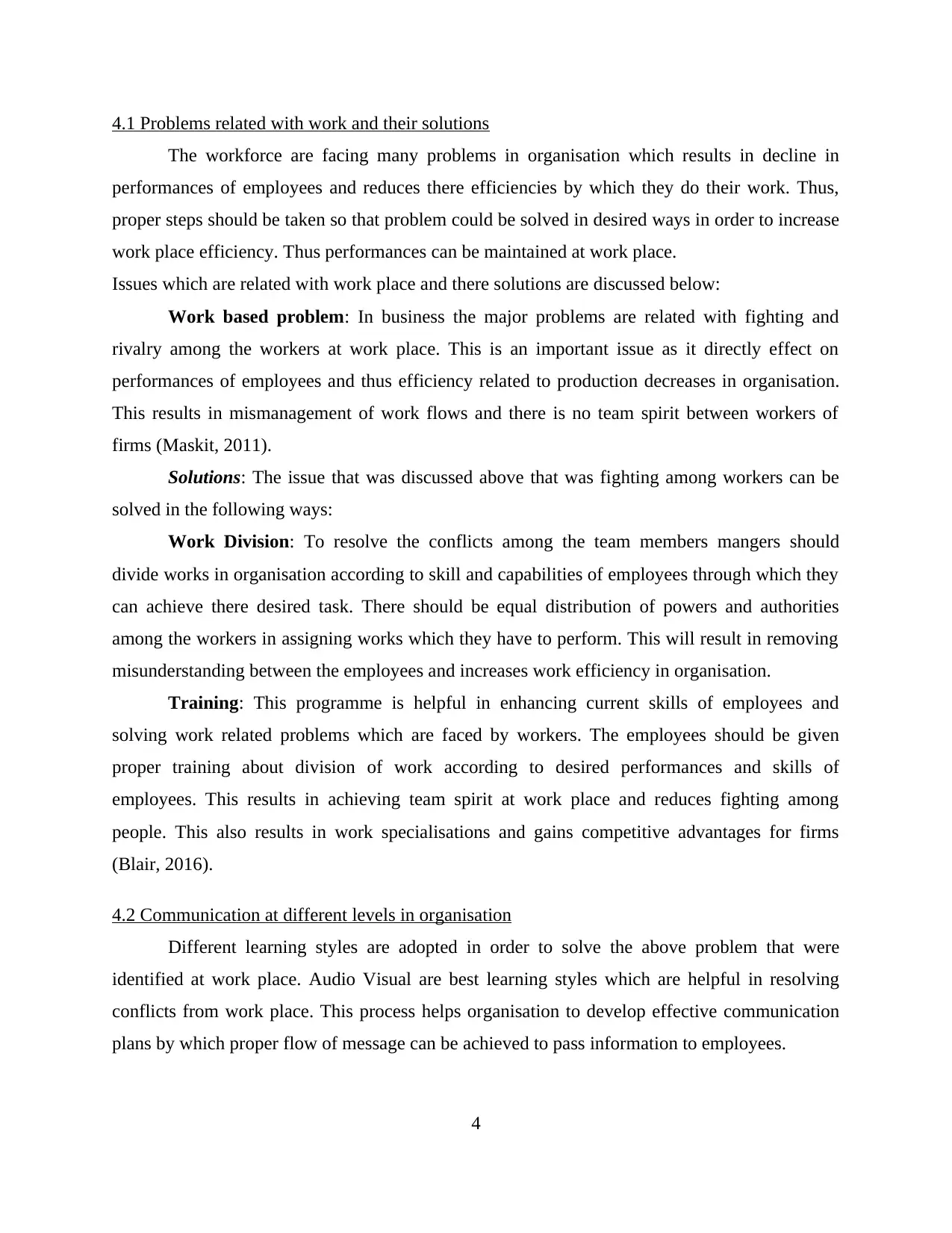
4.1 Problems related with work and their solutions
The workforce are facing many problems in organisation which results in decline in
performances of employees and reduces there efficiencies by which they do their work. Thus,
proper steps should be taken so that problem could be solved in desired ways in order to increase
work place efficiency. Thus performances can be maintained at work place.
Issues which are related with work place and there solutions are discussed below:
Work based problem: In business the major problems are related with fighting and
rivalry among the workers at work place. This is an important issue as it directly effect on
performances of employees and thus efficiency related to production decreases in organisation.
This results in mismanagement of work flows and there is no team spirit between workers of
firms (Maskit, 2011).
Solutions: The issue that was discussed above that was fighting among workers can be
solved in the following ways:
Work Division: To resolve the conflicts among the team members mangers should
divide works in organisation according to skill and capabilities of employees through which they
can achieve there desired task. There should be equal distribution of powers and authorities
among the workers in assigning works which they have to perform. This will result in removing
misunderstanding between the employees and increases work efficiency in organisation.
Training: This programme is helpful in enhancing current skills of employees and
solving work related problems which are faced by workers. The employees should be given
proper training about division of work according to desired performances and skills of
employees. This results in achieving team spirit at work place and reduces fighting among
people. This also results in work specialisations and gains competitive advantages for firms
(Blair, 2016).
4.2 Communication at different levels in organisation
Different learning styles are adopted in order to solve the above problem that were
identified at work place. Audio Visual are best learning styles which are helpful in resolving
conflicts from work place. This process helps organisation to develop effective communication
plans by which proper flow of message can be achieved to pass information to employees.
4
The workforce are facing many problems in organisation which results in decline in
performances of employees and reduces there efficiencies by which they do their work. Thus,
proper steps should be taken so that problem could be solved in desired ways in order to increase
work place efficiency. Thus performances can be maintained at work place.
Issues which are related with work place and there solutions are discussed below:
Work based problem: In business the major problems are related with fighting and
rivalry among the workers at work place. This is an important issue as it directly effect on
performances of employees and thus efficiency related to production decreases in organisation.
This results in mismanagement of work flows and there is no team spirit between workers of
firms (Maskit, 2011).
Solutions: The issue that was discussed above that was fighting among workers can be
solved in the following ways:
Work Division: To resolve the conflicts among the team members mangers should
divide works in organisation according to skill and capabilities of employees through which they
can achieve there desired task. There should be equal distribution of powers and authorities
among the workers in assigning works which they have to perform. This will result in removing
misunderstanding between the employees and increases work efficiency in organisation.
Training: This programme is helpful in enhancing current skills of employees and
solving work related problems which are faced by workers. The employees should be given
proper training about division of work according to desired performances and skills of
employees. This results in achieving team spirit at work place and reduces fighting among
people. This also results in work specialisations and gains competitive advantages for firms
(Blair, 2016).
4.2 Communication at different levels in organisation
Different learning styles are adopted in order to solve the above problem that were
identified at work place. Audio Visual are best learning styles which are helpful in resolving
conflicts from work place. This process helps organisation to develop effective communication
plans by which proper flow of message can be achieved to pass information to employees.
4
⊘ This is a preview!⊘
Do you want full access?
Subscribe today to unlock all pages.

Trusted by 1+ million students worldwide
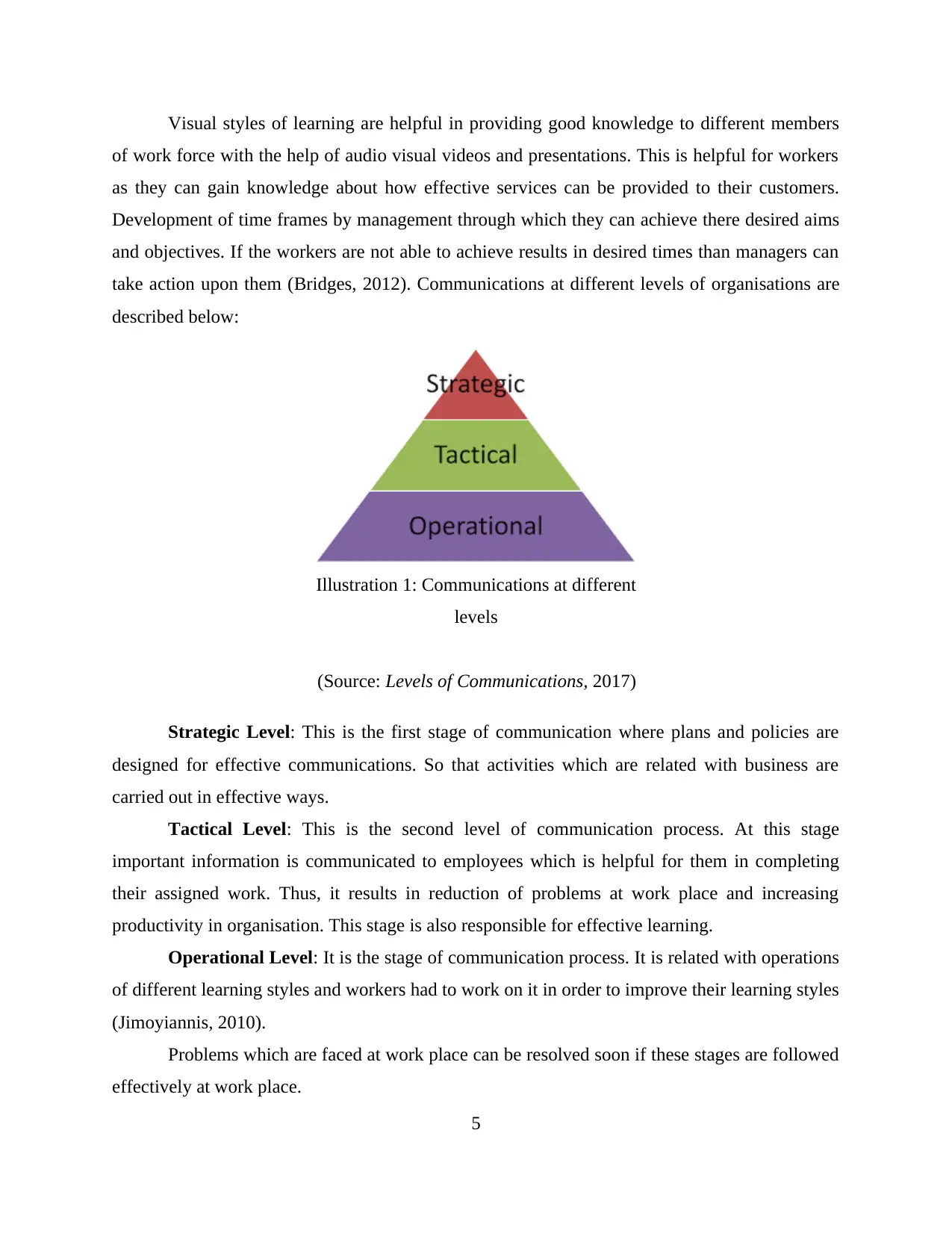
Visual styles of learning are helpful in providing good knowledge to different members
of work force with the help of audio visual videos and presentations. This is helpful for workers
as they can gain knowledge about how effective services can be provided to their customers.
Development of time frames by management through which they can achieve there desired aims
and objectives. If the workers are not able to achieve results in desired times than managers can
take action upon them (Bridges, 2012). Communications at different levels of organisations are
described below:
(Source: Levels of Communications, 2017)
Strategic Level: This is the first stage of communication where plans and policies are
designed for effective communications. So that activities which are related with business are
carried out in effective ways.
Tactical Level: This is the second level of communication process. At this stage
important information is communicated to employees which is helpful for them in completing
their assigned work. Thus, it results in reduction of problems at work place and increasing
productivity in organisation. This stage is also responsible for effective learning.
Operational Level: It is the stage of communication process. It is related with operations
of different learning styles and workers had to work on it in order to improve their learning styles
(Jimoyiannis, 2010).
Problems which are faced at work place can be resolved soon if these stages are followed
effectively at work place.
5
Illustration 1: Communications at different
levels
of work force with the help of audio visual videos and presentations. This is helpful for workers
as they can gain knowledge about how effective services can be provided to their customers.
Development of time frames by management through which they can achieve there desired aims
and objectives. If the workers are not able to achieve results in desired times than managers can
take action upon them (Bridges, 2012). Communications at different levels of organisations are
described below:
(Source: Levels of Communications, 2017)
Strategic Level: This is the first stage of communication where plans and policies are
designed for effective communications. So that activities which are related with business are
carried out in effective ways.
Tactical Level: This is the second level of communication process. At this stage
important information is communicated to employees which is helpful for them in completing
their assigned work. Thus, it results in reduction of problems at work place and increasing
productivity in organisation. This stage is also responsible for effective learning.
Operational Level: It is the stage of communication process. It is related with operations
of different learning styles and workers had to work on it in order to improve their learning styles
(Jimoyiannis, 2010).
Problems which are faced at work place can be resolved soon if these stages are followed
effectively at work place.
5
Illustration 1: Communications at different
levels
Paraphrase This Document
Need a fresh take? Get an instant paraphrase of this document with our AI Paraphraser
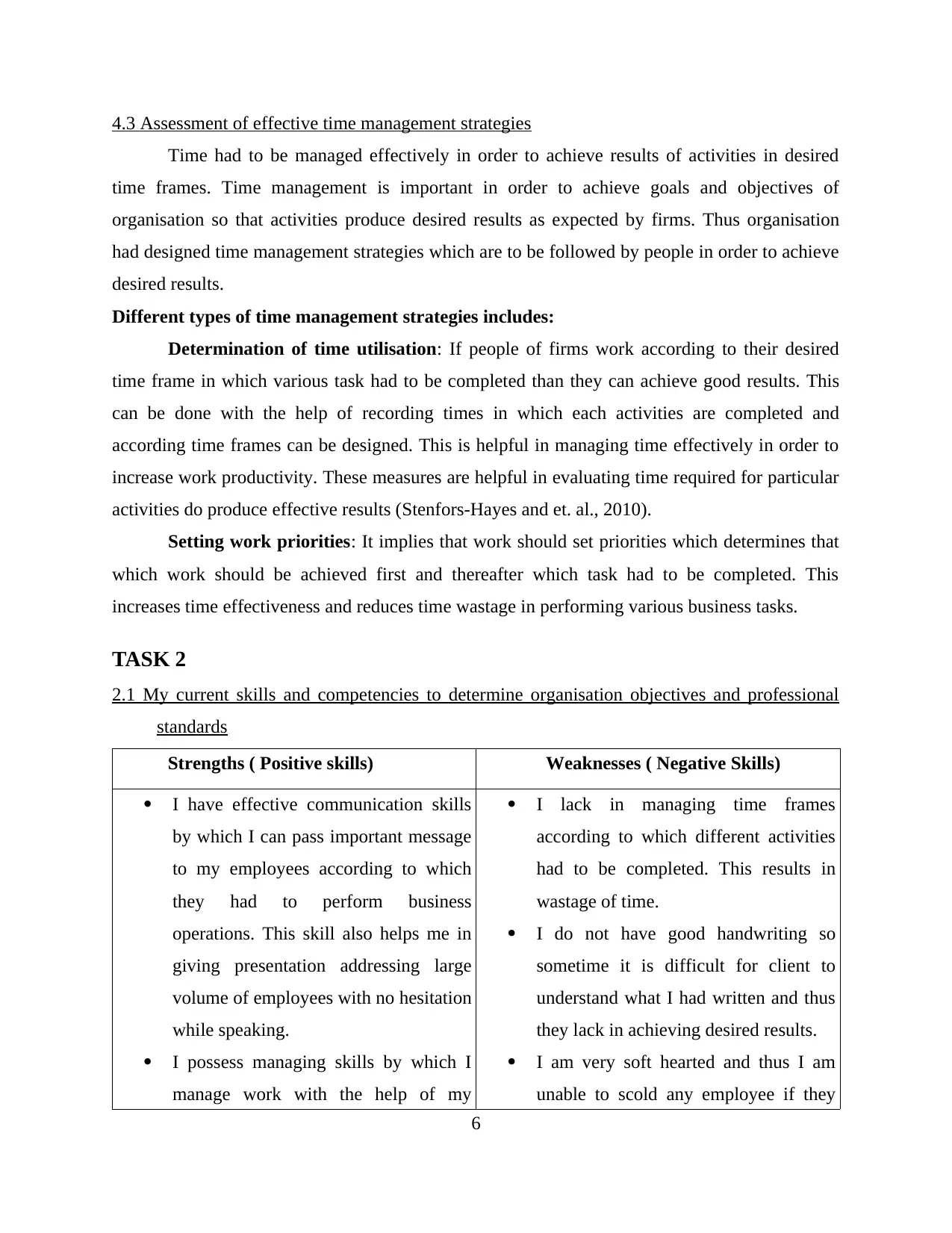
4.3 Assessment of effective time management strategies
Time had to be managed effectively in order to achieve results of activities in desired
time frames. Time management is important in order to achieve goals and objectives of
organisation so that activities produce desired results as expected by firms. Thus organisation
had designed time management strategies which are to be followed by people in order to achieve
desired results.
Different types of time management strategies includes:
Determination of time utilisation: If people of firms work according to their desired
time frame in which various task had to be completed than they can achieve good results. This
can be done with the help of recording times in which each activities are completed and
according time frames can be designed. This is helpful in managing time effectively in order to
increase work productivity. These measures are helpful in evaluating time required for particular
activities do produce effective results (Stenfors-Hayes and et. al., 2010).
Setting work priorities: It implies that work should set priorities which determines that
which work should be achieved first and thereafter which task had to be completed. This
increases time effectiveness and reduces time wastage in performing various business tasks.
TASK 2
2.1 My current skills and competencies to determine organisation objectives and professional
standards
Strengths ( Positive skills) Weaknesses ( Negative Skills)
I have effective communication skills
by which I can pass important message
to my employees according to which
they had to perform business
operations. This skill also helps me in
giving presentation addressing large
volume of employees with no hesitation
while speaking.
I possess managing skills by which I
manage work with the help of my
I lack in managing time frames
according to which different activities
had to be completed. This results in
wastage of time.
I do not have good handwriting so
sometime it is difficult for client to
understand what I had written and thus
they lack in achieving desired results.
I am very soft hearted and thus I am
unable to scold any employee if they
6
Time had to be managed effectively in order to achieve results of activities in desired
time frames. Time management is important in order to achieve goals and objectives of
organisation so that activities produce desired results as expected by firms. Thus organisation
had designed time management strategies which are to be followed by people in order to achieve
desired results.
Different types of time management strategies includes:
Determination of time utilisation: If people of firms work according to their desired
time frame in which various task had to be completed than they can achieve good results. This
can be done with the help of recording times in which each activities are completed and
according time frames can be designed. This is helpful in managing time effectively in order to
increase work productivity. These measures are helpful in evaluating time required for particular
activities do produce effective results (Stenfors-Hayes and et. al., 2010).
Setting work priorities: It implies that work should set priorities which determines that
which work should be achieved first and thereafter which task had to be completed. This
increases time effectiveness and reduces time wastage in performing various business tasks.
TASK 2
2.1 My current skills and competencies to determine organisation objectives and professional
standards
Strengths ( Positive skills) Weaknesses ( Negative Skills)
I have effective communication skills
by which I can pass important message
to my employees according to which
they had to perform business
operations. This skill also helps me in
giving presentation addressing large
volume of employees with no hesitation
while speaking.
I possess managing skills by which I
manage work with the help of my
I lack in managing time frames
according to which different activities
had to be completed. This results in
wastage of time.
I do not have good handwriting so
sometime it is difficult for client to
understand what I had written and thus
they lack in achieving desired results.
I am very soft hearted and thus I am
unable to scold any employee if they
6
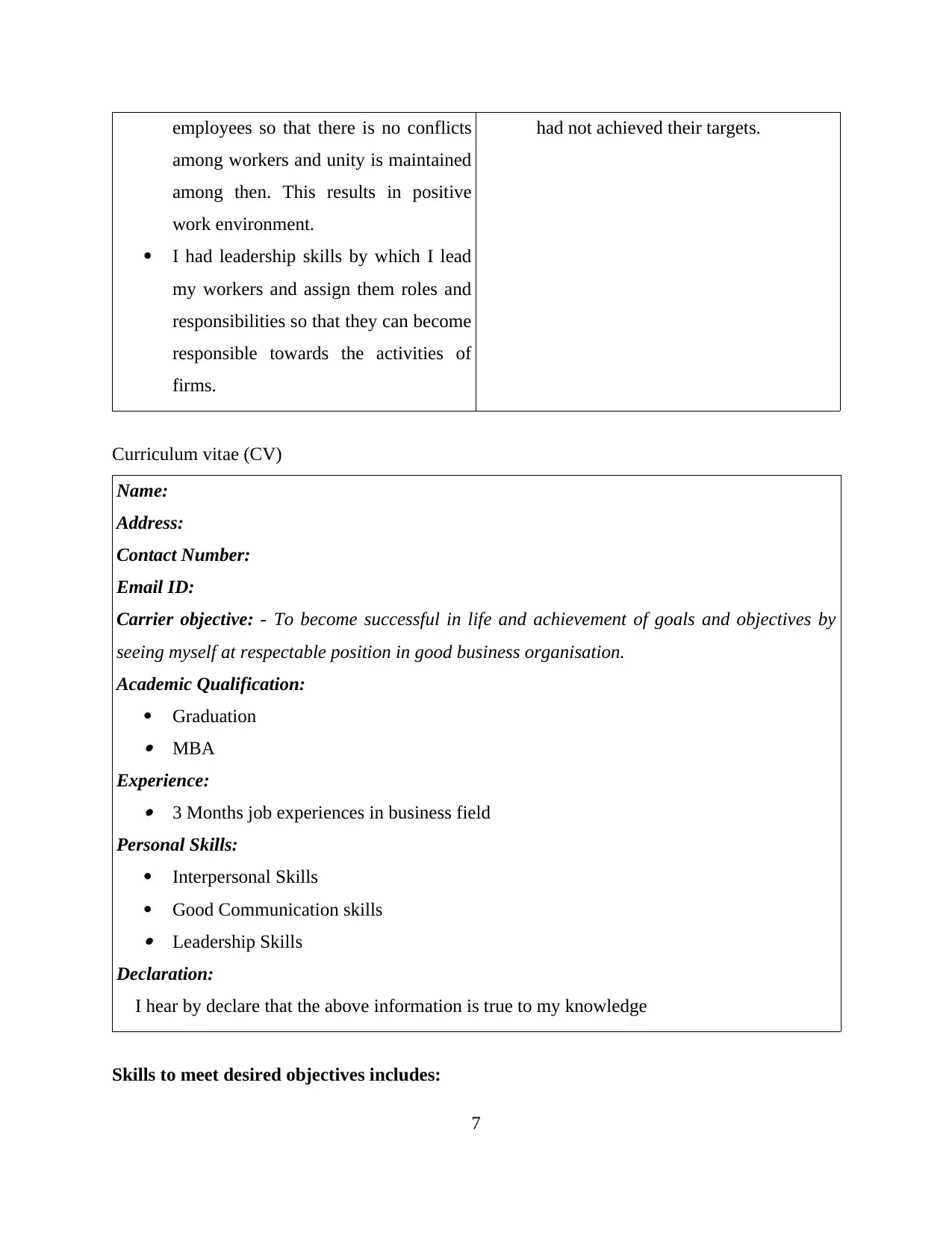
employees so that there is no conflicts
among workers and unity is maintained
among then. This results in positive
work environment.
I had leadership skills by which I lead
my workers and assign them roles and
responsibilities so that they can become
responsible towards the activities of
firms.
had not achieved their targets.
Curriculum vitae (CV)
Name:
Address:
Contact Number:
Email ID:
Carrier objective: - To become successful in life and achievement of goals and objectives by
seeing myself at respectable position in good business organisation.
Academic Qualification:
Graduation MBA
Experience: 3 Months job experiences in business field
Personal Skills:
Interpersonal Skills
Good Communication skills Leadership Skills
Declaration:
I hear by declare that the above information is true to my knowledge
Skills to meet desired objectives includes:
7
among workers and unity is maintained
among then. This results in positive
work environment.
I had leadership skills by which I lead
my workers and assign them roles and
responsibilities so that they can become
responsible towards the activities of
firms.
had not achieved their targets.
Curriculum vitae (CV)
Name:
Address:
Contact Number:
Email ID:
Carrier objective: - To become successful in life and achievement of goals and objectives by
seeing myself at respectable position in good business organisation.
Academic Qualification:
Graduation MBA
Experience: 3 Months job experiences in business field
Personal Skills:
Interpersonal Skills
Good Communication skills Leadership Skills
Declaration:
I hear by declare that the above information is true to my knowledge
Skills to meet desired objectives includes:
7
⊘ This is a preview!⊘
Do you want full access?
Subscribe today to unlock all pages.

Trusted by 1+ million students worldwide
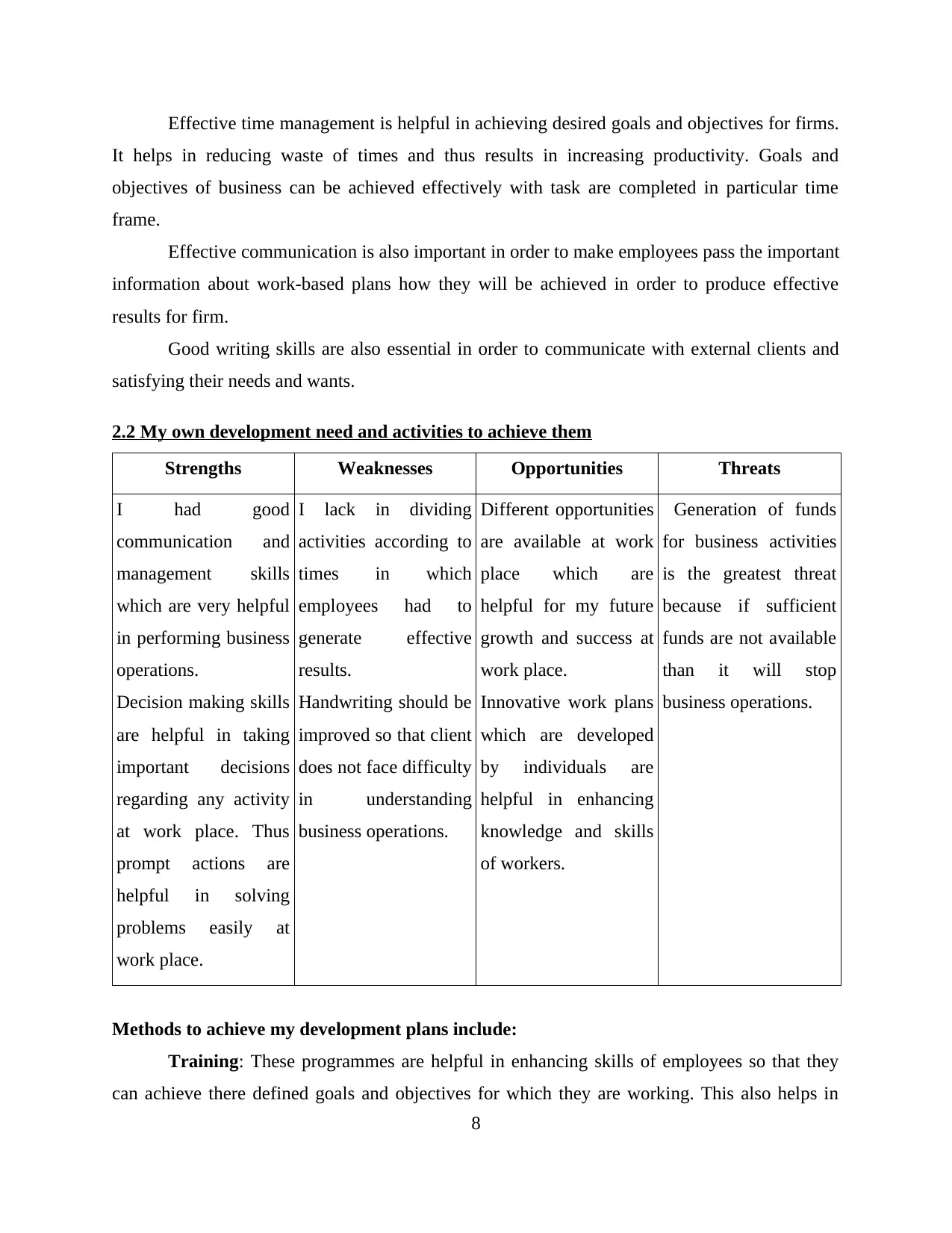
Effective time management is helpful in achieving desired goals and objectives for firms.
It helps in reducing waste of times and thus results in increasing productivity. Goals and
objectives of business can be achieved effectively with task are completed in particular time
frame.
Effective communication is also important in order to make employees pass the important
information about work-based plans how they will be achieved in order to produce effective
results for firm.
Good writing skills are also essential in order to communicate with external clients and
satisfying their needs and wants.
2.2 My own development need and activities to achieve them
Strengths Weaknesses Opportunities Threats
I had good
communication and
management skills
which are very helpful
in performing business
operations.
Decision making skills
are helpful in taking
important decisions
regarding any activity
at work place. Thus
prompt actions are
helpful in solving
problems easily at
work place.
I lack in dividing
activities according to
times in which
employees had to
generate effective
results.
Handwriting should be
improved so that client
does not face difficulty
in understanding
business operations.
Different opportunities
are available at work
place which are
helpful for my future
growth and success at
work place.
Innovative work plans
which are developed
by individuals are
helpful in enhancing
knowledge and skills
of workers.
Generation of funds
for business activities
is the greatest threat
because if sufficient
funds are not available
than it will stop
business operations.
Methods to achieve my development plans include:
Training: These programmes are helpful in enhancing skills of employees so that they
can achieve there defined goals and objectives for which they are working. This also helps in
8
It helps in reducing waste of times and thus results in increasing productivity. Goals and
objectives of business can be achieved effectively with task are completed in particular time
frame.
Effective communication is also important in order to make employees pass the important
information about work-based plans how they will be achieved in order to produce effective
results for firm.
Good writing skills are also essential in order to communicate with external clients and
satisfying their needs and wants.
2.2 My own development need and activities to achieve them
Strengths Weaknesses Opportunities Threats
I had good
communication and
management skills
which are very helpful
in performing business
operations.
Decision making skills
are helpful in taking
important decisions
regarding any activity
at work place. Thus
prompt actions are
helpful in solving
problems easily at
work place.
I lack in dividing
activities according to
times in which
employees had to
generate effective
results.
Handwriting should be
improved so that client
does not face difficulty
in understanding
business operations.
Different opportunities
are available at work
place which are
helpful for my future
growth and success at
work place.
Innovative work plans
which are developed
by individuals are
helpful in enhancing
knowledge and skills
of workers.
Generation of funds
for business activities
is the greatest threat
because if sufficient
funds are not available
than it will stop
business operations.
Methods to achieve my development plans include:
Training: These programmes are helpful in enhancing skills of employees so that they
can achieve there defined goals and objectives for which they are working. This also helps in
8
Paraphrase This Document
Need a fresh take? Get an instant paraphrase of this document with our AI Paraphraser
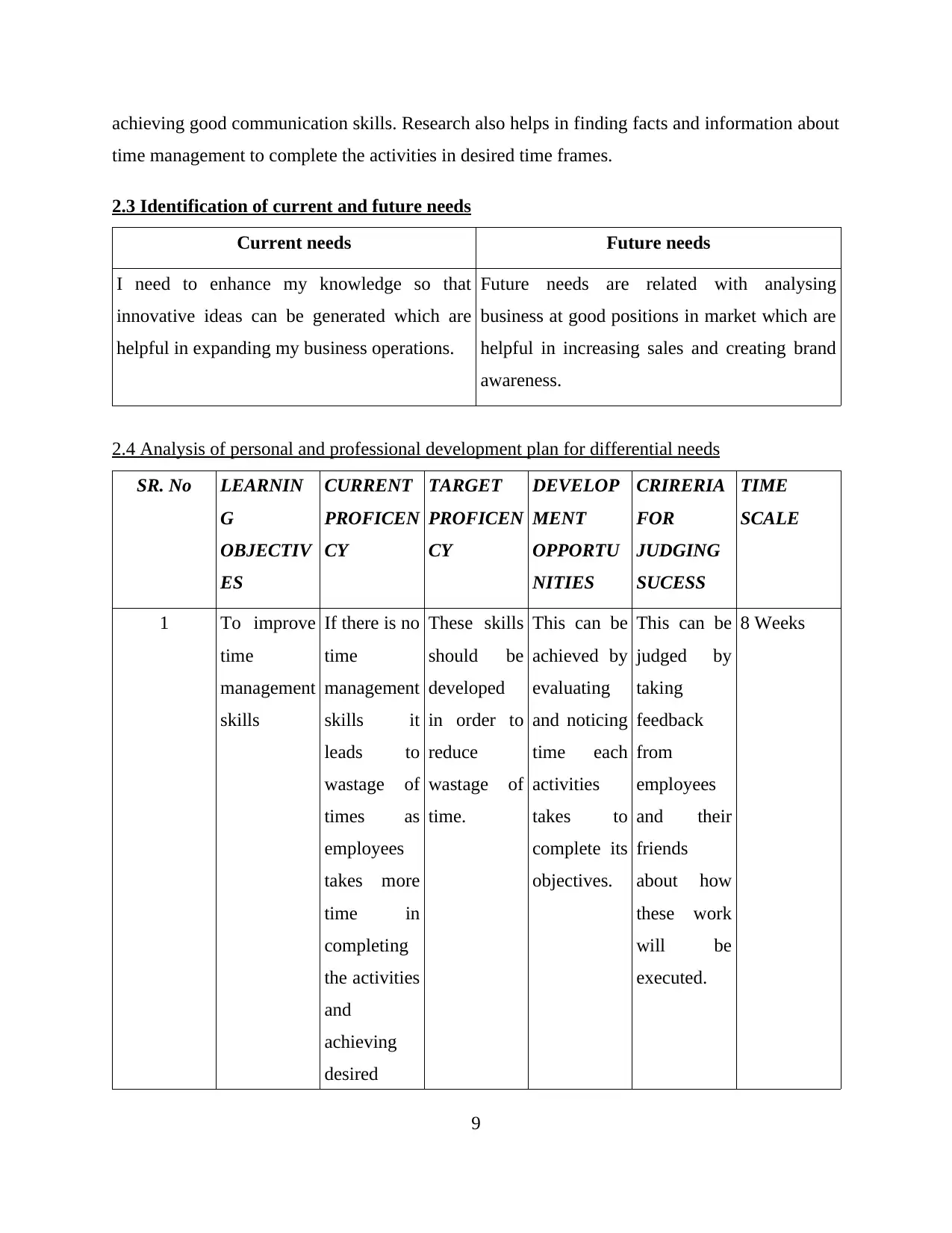
achieving good communication skills. Research also helps in finding facts and information about
time management to complete the activities in desired time frames.
2.3 Identification of current and future needs
Current needs Future needs
I need to enhance my knowledge so that
innovative ideas can be generated which are
helpful in expanding my business operations.
Future needs are related with analysing
business at good positions in market which are
helpful in increasing sales and creating brand
awareness.
2.4 Analysis of personal and professional development plan for differential needs
SR. No LEARNIN
G
OBJECTIV
ES
CURRENT
PROFICEN
CY
TARGET
PROFICEN
CY
DEVELOP
MENT
OPPORTU
NITIES
CRIRERIA
FOR
JUDGING
SUCESS
TIME
SCALE
1 To improve
time
management
skills
If there is no
time
management
skills it
leads to
wastage of
times as
employees
takes more
time in
completing
the activities
and
achieving
desired
These skills
should be
developed
in order to
reduce
wastage of
time.
This can be
achieved by
evaluating
and noticing
time each
activities
takes to
complete its
objectives.
This can be
judged by
taking
feedback
from
employees
and their
friends
about how
these work
will be
executed.
8 Weeks
9
time management to complete the activities in desired time frames.
2.3 Identification of current and future needs
Current needs Future needs
I need to enhance my knowledge so that
innovative ideas can be generated which are
helpful in expanding my business operations.
Future needs are related with analysing
business at good positions in market which are
helpful in increasing sales and creating brand
awareness.
2.4 Analysis of personal and professional development plan for differential needs
SR. No LEARNIN
G
OBJECTIV
ES
CURRENT
PROFICEN
CY
TARGET
PROFICEN
CY
DEVELOP
MENT
OPPORTU
NITIES
CRIRERIA
FOR
JUDGING
SUCESS
TIME
SCALE
1 To improve
time
management
skills
If there is no
time
management
skills it
leads to
wastage of
times as
employees
takes more
time in
completing
the activities
and
achieving
desired
These skills
should be
developed
in order to
reduce
wastage of
time.
This can be
achieved by
evaluating
and noticing
time each
activities
takes to
complete its
objectives.
This can be
judged by
taking
feedback
from
employees
and their
friends
about how
these work
will be
executed.
8 Weeks
9
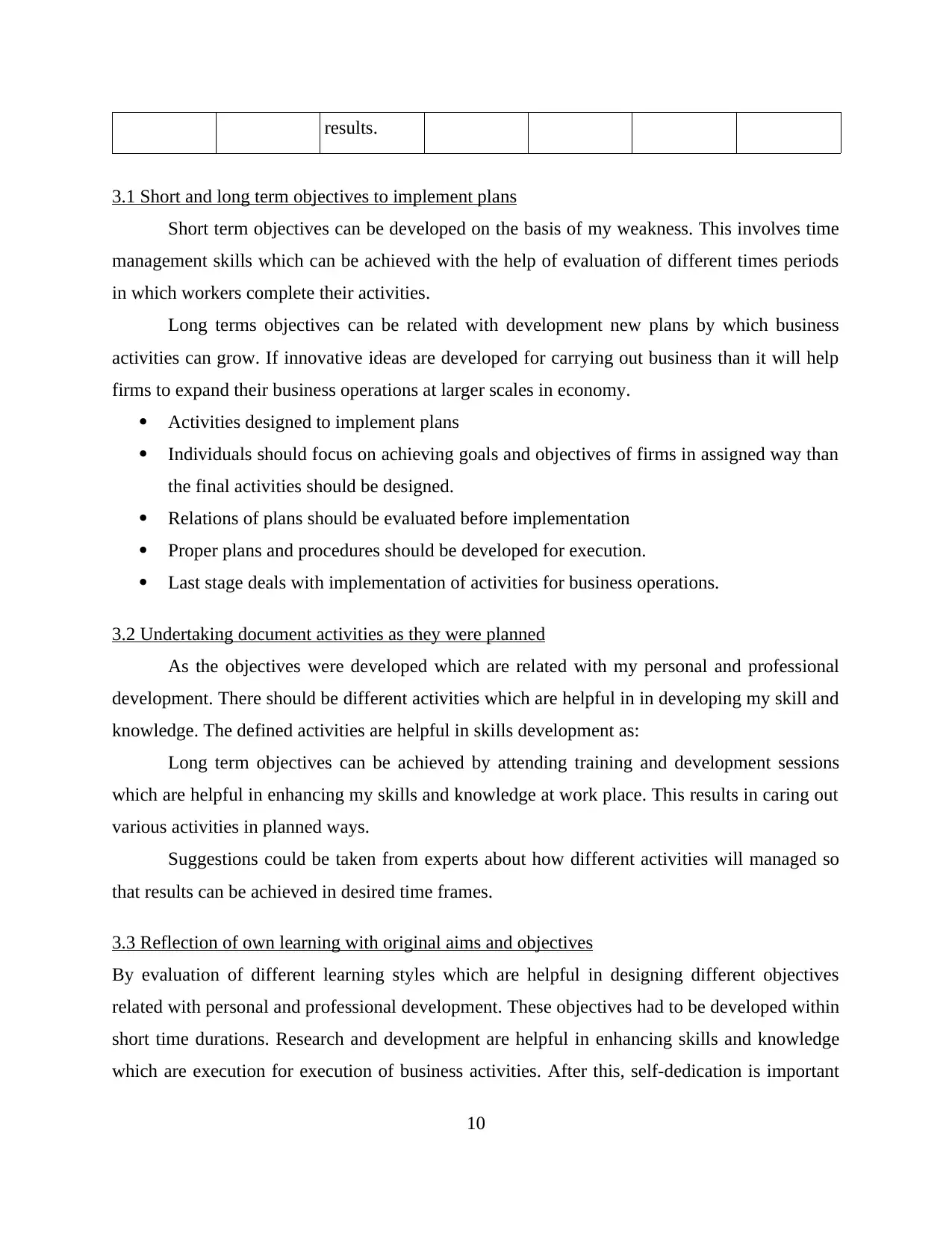
results.
3.1 Short and long term objectives to implement plans
Short term objectives can be developed on the basis of my weakness. This involves time
management skills which can be achieved with the help of evaluation of different times periods
in which workers complete their activities.
Long terms objectives can be related with development new plans by which business
activities can grow. If innovative ideas are developed for carrying out business than it will help
firms to expand their business operations at larger scales in economy.
Activities designed to implement plans
Individuals should focus on achieving goals and objectives of firms in assigned way than
the final activities should be designed.
Relations of plans should be evaluated before implementation
Proper plans and procedures should be developed for execution.
Last stage deals with implementation of activities for business operations.
3.2 Undertaking document activities as they were planned
As the objectives were developed which are related with my personal and professional
development. There should be different activities which are helpful in in developing my skill and
knowledge. The defined activities are helpful in skills development as:
Long term objectives can be achieved by attending training and development sessions
which are helpful in enhancing my skills and knowledge at work place. This results in caring out
various activities in planned ways.
Suggestions could be taken from experts about how different activities will managed so
that results can be achieved in desired time frames.
3.3 Reflection of own learning with original aims and objectives
By evaluation of different learning styles which are helpful in designing different objectives
related with personal and professional development. These objectives had to be developed within
short time durations. Research and development are helpful in enhancing skills and knowledge
which are execution for execution of business activities. After this, self-dedication is important
10
3.1 Short and long term objectives to implement plans
Short term objectives can be developed on the basis of my weakness. This involves time
management skills which can be achieved with the help of evaluation of different times periods
in which workers complete their activities.
Long terms objectives can be related with development new plans by which business
activities can grow. If innovative ideas are developed for carrying out business than it will help
firms to expand their business operations at larger scales in economy.
Activities designed to implement plans
Individuals should focus on achieving goals and objectives of firms in assigned way than
the final activities should be designed.
Relations of plans should be evaluated before implementation
Proper plans and procedures should be developed for execution.
Last stage deals with implementation of activities for business operations.
3.2 Undertaking document activities as they were planned
As the objectives were developed which are related with my personal and professional
development. There should be different activities which are helpful in in developing my skill and
knowledge. The defined activities are helpful in skills development as:
Long term objectives can be achieved by attending training and development sessions
which are helpful in enhancing my skills and knowledge at work place. This results in caring out
various activities in planned ways.
Suggestions could be taken from experts about how different activities will managed so
that results can be achieved in desired time frames.
3.3 Reflection of own learning with original aims and objectives
By evaluation of different learning styles which are helpful in designing different objectives
related with personal and professional development. These objectives had to be developed within
short time durations. Research and development are helpful in enhancing skills and knowledge
which are execution for execution of business activities. After this, self-dedication is important
10
⊘ This is a preview!⊘
Do you want full access?
Subscribe today to unlock all pages.

Trusted by 1+ million students worldwide
1 out of 15
Related Documents
Your All-in-One AI-Powered Toolkit for Academic Success.
+13062052269
info@desklib.com
Available 24*7 on WhatsApp / Email
![[object Object]](/_next/static/media/star-bottom.7253800d.svg)
Unlock your academic potential
Copyright © 2020–2025 A2Z Services. All Rights Reserved. Developed and managed by ZUCOL.





